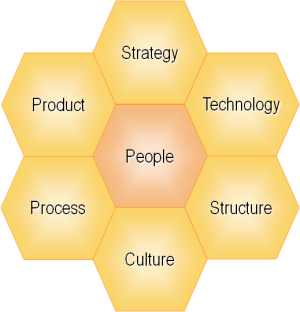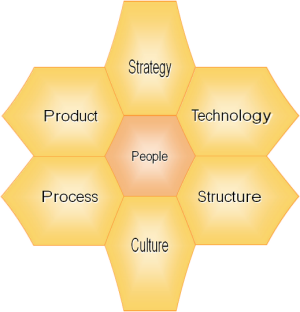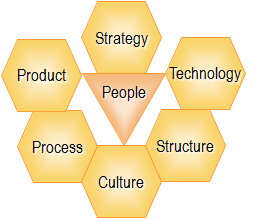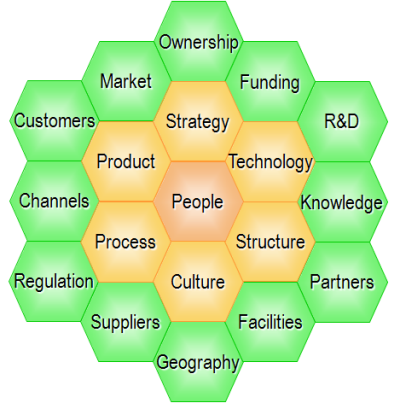 Here
are seven common targets for business change. In each case,
changing that aspect might be a prime objective of the business
change programme - or it might just be an inevitable consequence.
Here
are seven common targets for business change. In each case,
changing that aspect might be a prime objective of the business
change programme - or it might just be an inevitable consequence.
Business change can be a complex, multi-faceted undertaking. It can be deceptively hard to achieve. Many, if not most, change programmes fall short of their expectations and objectives.
Organisations form complex, interacting ecosystems, often resistant to attack and self-healing. There is a growing realisation that many business changes cannot be accomplished solely through structured, planned, logical activities. Their nature may be explained by the tenets of chaos and complexity theories as much as the laws of logic. However clear the vision and strategy of the organisation, the desired change may remain incomplete, even formless and vague. Change is increasingly being seen as a continuous process. In some cases it may be achieved in definable stages. In others, it may be an endless pursuit of the organisation's evolving goals.
In this section we examine how to deliver those business change programmes where structure can be applied. We start with some definitions then build up to an overall model for business change:
In the second part we summarise the approach and some of the techniques:
The terms "programme", "portfolio" and "project" are often confused. They do share similarities and many project management concepts apply to all three. There are also important distinctions to be made.
Type of Endeavour |
|
Project |
A project is an undertaking for a limited duration which is not part of routine operations. A project team will be temporarily assigned, reporting to a single Project Manager. A project has a defined objective and scope. The overall deliverable will be of value, but does not necessarily generate benefit on its own. |
Portfolio |
A portfolio is a group of projects with no common objective other than the overall well-being of the organisation. It is often convenient and efficient to manage unrelated groups of projects, for example, to balance priorities, to manage resources, to apply common standards, and to achieve economies of scale. |
Programme |
A programme is a group of projects (or related initiatives) which collectively achieve a beneficial objective. The projects may address different aspects of the overall change and may follow different timelines. Programmes often have a long duration such that some future activities are only aspirational ideas when the programme is first defined. There will be a management team guiding the overall programme in addition to the project managers for each individual project. |
Further commentary can be found in the section dealing with the relationship between Programmes and Projects.
Further confusion arises between IT activities, business change, and other forms of change initiative. For example, when you talk to an IT Project Manager about operational readiness the emphasis will be on whether the technology works correctly. If you talk to a business manager you will have a much broader conversation - for example does the workforce have the required competency, are the customers aware of the changes, how accurate is our information?
Type of Change |
|
IT Change |
IT initiatives primarily address technological change. They deliver components such as new systems and technical infrastructure. Contact with other parts of the organisation is typically limited to establishing requirements, acceptance testing, end-user training and operational support. |
Business Change |
Business change initiatives usually address all the aspects required to make a change in the way the business works. Even in a technology-driven change, there will be many non-IT aspects, for example, initial evaluation of the case for change, securing the funding, commercial deals, introducing new business processes, organisational change, recruitment, facilities, internal communication (stakeholders, management, workforce) and external communication (customers, suppliers, partners, third parties). |
Other |
Project and programme management is applied to many other forms of change, for example, construction, engineering, product development, and social change. |
All combinations of these concepts exist. Here are some examples:
Type |
IT |
Business |
Project |
Replace the General Ledger application |
Investigate whether there is a market for a new product |
Portfolio |
All projects reporting to the IT Development Manager |
All initiatives handled by the Marketing Director |
Programme |
Integrate the CRM system with various customer facing systems |
Set up an eCommerce channel to market |
While you are following this section you might like to page through the Flash animation or take a look the PowerPoint presentation "Business Change Programmes".
There can be many drivers of business change and many targets for the change. Drivers are those compelling reasons to undertake the change, for example:
The targets for the change are the various aspects of the organisation - its nature, structure, modus operandi, product lines, technology etc.
 Here
are seven common targets for business change. In each case,
changing that aspect might be a prime objective of the business
change programme - or it might just be an inevitable consequence.
Here
are seven common targets for business change. In each case,
changing that aspect might be a prime objective of the business
change programme - or it might just be an inevitable consequence.
Even in technology-driven projects, the technological change is not usually the central issue. To build a business-to-consumer eCommerce system we can use well-established concepts and many off-the-shelf software components. That change may be easy in comparison to shifting the organisation's market strategy, building new call-centre capabilities, hiring new staff, establishing new roles, introducing new administrative processes, setting up fulfilment through partner agreements, marketing the new channel to the public, and achieving a profitable new business model.
The heart of the business is usually its people. It is the leadership and workforce who are behind every aspect of every change. The imperative is to harness their support, enthusiasm, and effort. They will make the change a success.
 Business
change is rarely confined to one area of the business.
Any significant change is likely to target several
aspects of the business and have implications for even
more. A movement in one aspect will distort the others.
If I change one part of the model I must make changes in
them all if it is to continue to fit. Business
change is rarely confined to one area of the business.
Any significant change is likely to target several
aspects of the business and have implications for even
more. A movement in one aspect will distort the others.
If I change one part of the model I must make changes in
them all if it is to continue to fit.When you change the shape and nature of one aspect, you will probably need to make adjustments to other aspects. When contemplating and planning a change programme you should think through the desired changes and consequences across the organisation. There is no point changing the strategy unless it affects the things the organisation does such as its products and services. New products or services may mean new processes. Different ways of doing things also means new processes. Processes are performed by people. The way the people operate is managed through organisational structure. The way people behave is driven by culture. Processes are enabled by technology. |
 When a change is transformational (ie there is a fundamental difference that will be observed by everyone), aspects of the business may be changed out of all recognition. There is every chance that the organisation will no longer fit together - unless action is taken to address all impacts of the change. Readjustment is inevitable. You need to re-shape all aspects of the business to achieve a new and better organisation. It may be difficult to re-build something as elegant and comfortable. In a world of continuous change, organisations might never have the time to settle down before the next re-shaping. Indeed, a good change objective might be to achieve a culture where change is welcomed and encouraged.
Of course, the realities of the real-world organisation cannot be mapped as a simple two-dimensional picture. Your organisation's complexities will present a challenge only you can address. |
Business change is a difficult journey into the unknown. However well we imagine the destination and however well we plan the trip, we can be sure that things will work out differently. The further we are into the journey, the less likely it is that we will have held to our original plans and expectations. We can usually see what is immediately ahead, but we must climb to the next ridge before we know what the next stage will look like.
By the time we reach the destination it might well look very different to our expectations. Maybe it is not even the destination we intended and, maybe, we do not want to or cannot stop travelling when we get there.
The first step in a business change is to realise that change is required. No methodology can explain how the leadership of an organisation comes to such a conclusion (although many try). Typically, the idea is tentatively raised by an individual with the inspiration to realise that the organisation could be more successful if changes were made. There follows a period during which various loosely knit ideas are proposed and evaluated until there is a persuasive argument in favour of a definable change. This is refined until there is sufficient detail to present the board with a compelling case for change.
Before we start work on the change, we need a reliable view on how to achieve that change and what its true resource requirements, timing, costs and benefits will be. A conceptual design should be made for every aspect of the change. It is common to speak of conceptual design in terms of technology components, but we should also be looking at things such as changes to roles, organisational structures, competencies, culture, processes, etc. We should also be considering how to achieve those changes - not just the desired end-state.
Using the conceptual design as our framework, we can then start the real work. We design the detail for each aspect of the business change. For example, we should design people and process solutions just as we do technology changes - albeit using different methods, tools and techniques. We should also design the specific approaches and activities that are required to achieve those goals.
Bear in mind that not all business change can be defined or designed in a formalised manner. In some cases, for example a cultural change, the desired change might remain a loosely-defined concept and the steps to be taken would encourage movement in the desired direction rather than follow firm designs. Even so, you should be able to specify many of the actions to be taken, whether or not you can design the desired end-state.
The detailed designs are used as specifications for the development of content for the change, for example:
Completed components are tested and validated, ready to be deployed. Deployment is rarely an instantaneous activity. Many components are required in advance of the main change, for example training, organisational change, equipment, publicity, etc. As well as the time taken to achieve the immediate transition, any significant change is likely to require continuing promotion and support to achieve optimum business benefit. Deployment work should evolve into continuous, pro-active management of the business area, always with a view to achieving optimum benefit.
We take a more detailed look at this change journey below.
 We looked before at seven core aspects of business change. These
are the areas that are most commonly addressed by business change
programmes. There are, however, many other aspects which might be
a focus of change or affected by a change elsewhere. Here is a
more complete list:
We looked before at seven core aspects of business change. These
are the areas that are most commonly addressed by business change
programmes. There are, however, many other aspects which might be
a focus of change or affected by a change elsewhere. Here is a
more complete list:
When we speak of the aspects of a business change we might mean any or all of these. Moreover, we often find several significant aspects within one of these headline aspects. For example:
We need to recognise each significant aspect and guide its progress through the change journey. Each will take its own course, but form an essential part of the overall transition.
 |
Let us take a look at what is going on inside the various workstreams of the change journey. You might imagine there is a continuous stream of activity, following the overall lifecycle, delivering each aspect of the change. Real-world programmes are rarely so simple.
 |
In the real world you will probably find:
In a world without programme management there may be much worse to observe. Even with clearly stated corporate objectives, there is likely to be chaos in the individual initiatives and projects undertaken by the many managers concerned. However good the individual managers, they are unlikely to create changes that fully align to the strategy, fit together without gaps or overlaps, deliver the change in an efficient manner, and stay on course to deliver the desired collective change.
 |
The natural tendency is towards chaos. The imperative is to guide individual efforts towards the organisation's goals. It is unlikely that any complex change could be managed with such rigidity that the results of each project fit perfectly. The art of programme management is to create harmony, order and direction from chaos.
You will need the support of the executive and sponsors. Establish a regime such that:
 |
Bear in mind that corporate objectives and the organisation's environment will inevitably vary over the lifespan of the change programme. In the illustration above, there has been a noticeable change of direction. Some projects were able to take up the new direction from the beginning, some had to make mid-life changes, and others required supplemental projects to complete the change.
Strong programme management is required from start to finish - not to rule with a rigid stick but to define, instigate, promote, guide and co-ordinate the many initiatives throughout the change journey.
Much of the work in a business change programme is best done by the organisation’s own people, guided and facilitated by specialists. There are four clear advantages. Participation of the management and workforce:
Conversely, there is benefit in bringing in people from outside. For example:
There are many valuable sources of knowledge, ideas and guidance that should be exploited throughout the change journey. For example:
Corporate strategy
Other divisions and specialist functions
Workforce
Customers
Suppliers
Competitors
Other industries
|
Case for Change |
Conceptual Design |
Detailed Design |
Development |
Deployment |
| Programme
Charter Vision Key Performance Indicators Focus Areas Stretch Targets Case for Change |
Current
Position Best Practices Options Future Solution Quick Wins Transition Strategy Business Case |
Pilots
& Prototypes Detailed Process Descriptions Organisational Design Technology Design Training Design Change Management Plan |
Technology
Acquisition, Development and Installation Process Documentation Training Development Change Communication Organisational Transition Deployment Plan |
Training Readiness Checks User Acceptance Solution Rollout Continuous Improvement Process |
The detailed approach to business change programmes is a subject for specific methodologies and will vary depending upon circumstance. Here is a summary of typical activities.
Business Change Activities |
|
| Case for Change | |
| Programme Charter | In the earliest stages of a business
change initiative there is unlikely to be a formalised
definition or structure for the work. When the change is
sufficiently well understood, a change programme should
be defined. The definition will include initial
descriptions of:
|
| Vision | The work may involve reviewing the vision for the overall organisation. If the corporate vision is already clearly defined and understood, the vision for the change programme (within the defined scope) might be derived from the organisation's overall goals. |
| Key Performance Indicators | Key Performance Indicators identify
specific measures of corporate performance. These may be
used in two ways:
|
| Focus Areas | The initial definition of the desired change is often very broad. Not every aspect of change will deliver the same degree of benefit. Which specific areas are worth focusing on? |
| Stretch Targets | If dramatic change is desired, there is no point setting easily achievable targets. Stretch targets identify how good performance would be in an ideal world. Although it should be understood that the team is unlikely to achieve perfection, everyone should strive as far as possible in that direction. For example, do not say our target is to improve lead times by 50% - maybe the ideal target would be zero lead time. Then see what you could possibly do to come close to that. |
| Case For Change | By now you should have enough
understanding to define a compelling case for change. The
case should explain:
|
| Conceptual Design | |
| Current Position | It is usually important to understand
the current position regarding each aspect of the change.
This would include such things as:
The rationale is that:
If the current "as-is" analysis does not contribute to one of these needs, it is probably not worth doing. Similarly, the amount of analysis performed should not exceed that which is valuable. |
| Best Practices | For each aspect, define what is current best practice. Call upon internal and external sources of knowledge. Seek benchmarks and "world-class" solutions. Look for the latest industry and subject matter wisdom. Investigate what further developments are likely during the course of the programme. |
| Options | Using the results from the fact-finding, formulate options for how the change might best be achieved. Analyse the pros and cons of these options such that the best options may be proposed. Agree the preferred choices with leadership and sponsors. Seek and obtain buy-in from other parties involved. |
| Future Solution | For each aspect of change, define the
target solution and how it would be achieved. Use
sufficient detail such that:
Do not create unnecessary detail - this might restrict the freedom of the solution designers to create the optimum solution. |
| Quick Wins | Although it might not be part of the main change journey, it is possible that the analysis has uncovered improvements that could be achieved rapidly, without waiting for the main change programme to produce its results. Suppose, for example, that daily stock reports were desired. It might be the case that the IT department could run the existing report daily instead of monthly with no development effort whatsoever. |
| Transition Strategy | Change programmes are often long, complex processes. Change is rarely achieved in a single step. Consider now the best path to achieve the overall change. |
| Business Case | You will identify costs and benefits at several stages. By now you will have reliable definitions of the work, timing, costs and benefits. A formal business case should be created, presented and agreed. It will form the prime basis for measuring the success of the programme. |
| Detailed Design | |
| Pilots and Prototypes | Designs can be created theoretically on
the drawing board, or they can evolve from trying things
out. Pilots and prototypes may be valuable design tools
when feasible.
|
| Detailed Process Descriptions | The new business processes will be mapped and described in complete detail. These descriptions may form the basis for procedural development, IT systems design, training materials, communications etc. |
| Organisational Design | Changes to organisational structures, roles, responsibilities, capabilities, competencies, job descriptions and resource levels will be defined. Transition strategies and plans will also be formulated. Timing is usually important. People cannot be changed, educated, moved, hired or terminated overnight. Where significant changes are being made to job descriptions and contracts, there may be legal requirements for notice periods and consultation. There will be organisational change management consequences affecting willingness to change, loyalty, motivation, etc. These should be a major input to the change management planning (see below). |
| Technology Design | Technological aspects will be designed
in detail. These may include:
|
| Training Design | Identify all populations that need to be educated and what skills or knowledge they need to acquire. Establish the best timing for the education and assess the practicalities of that timing. Consider the best format, styles, media, locations, and personnel for the training. Design the contents for each training component. |
| Change Management Plan | Organisational change management (ie changing behaviours and attitudes) is an important aspect throughout the programme. By this stage you will have established what change is required and what resistance is expected. Formulate the plan for overcoming the barriers and delivering the change. |
| Development | |
| Technology Acquisition, Development and Installation | Based on the detailed designs, the various technology components will be constructed. For some components it will simply be a case of selecting, acquiring, installing and configuring standard components. In other cases, it may involve a long, complex process of software development. |
| Process Documentation | New business processes should be supported by good user documentation. These days, it is unlikely to mean huge volumes of text. It is more likely to be contained directly within the computer applications, or specific workflow and knowledge management systems. |
| Training Development | Content for the training modules should be developed. Note the need to have reliable input. Subject matter needs to be described and incorporated in its final format - for example, computer applications, procedural documentation, and forms. This will affect the timing of the training development work. |
| Change Communication | Communication
is an important tool throughout the change programme. It
is used in building the case for change, establishing
commitment, encouraging participation, and ensuring the
designs are right. Typically, however, it becomes a
weapon rather than a tool when the organisational and
behavioural change is brought about. During this period
the major change communications will be prepared and
broadcast. There are two main types of message:
|
| Organisational Transition | Many of the organisational changes will need to be in place before the deployment of the new business solution. The process may need to commence months earlier. The transition will also continue into the deployment stage. |
| Deployment Plan | The Deployment Plan provides the final tactical details for switching over to the new business solution. |
| Deployment | |
| Training | Training is delivered in accordance with the Training Plan. A management process should be in place to ensure all individuals achieve the required competency and knowledge. It is inevitable that some people will miss planned sessions or fail to achieve required levels. Adjustments to schedules and remedial training may be required. |
| Readiness Checks | Before deciding to proceed with the
change, the readiness of all aspects should be checked.
It is not just a question of testing
the IT systems. It is equally important that all aspects
of change are ready, for example:
|
| User Acceptance | User acceptance is the formal acceptance by the organisation that the solution is sufficiently fit for purpose. Bear in mind that no complex solution is ever perfect. Criteria will have been set in advance to define what type and degree of non-conformity might be tolerated for the sake of achieving live operation. User Acceptance should always be conducted in a planned, structured and scientific manner to ensure reliable results. |
| Solution Rollout | The business change is made, for example, new IT systems and processes become operational. This might be an instantaneous event or it might be a phased change over, possibly involving the simultaneous operation of old and new regimes for a limited period. |
| Continuous Improvement | The work of the change programme does not finish with live operations. After deployment there will be a need for high levels of encouragement, guidance and support. Beyond that, there should be a permanent focus on delivering optimum benefit. |
 Business
change programmes involve activities across an organisation,
addressing different aspects of the business, following a complex
timetable. These activities are blended by the programme
management team to deliver the overall collective benefit.
Business
change programmes involve activities across an organisation,
addressing different aspects of the business, following a complex
timetable. These activities are blended by the programme
management team to deliver the overall collective benefit.
The programme management team needs to act as visionaries, entrepreneurs, politicians, ambassadors, coaches and planners, as well as controlling the individual project managers. Programme managers concern themselves with every matter that collectively adds to the success of the business change initiative. They will act with direct power from the board, cutting across organisational divisions.
Programme management is a highly specialised skill. It requires great experience to derive optimum benefit from a change programme. Given a choice, look for the manager who knows how to deal with transformational business change rather than one who is only specialised in one aspect such as the industry or technology.
 |
| Copyright © Simon Wallace, 1999-2016 |